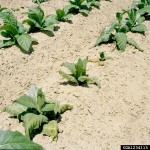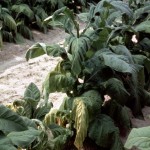Bacterial Wilt (Granville Wilt)
Varieties Resistant to Bacterial Wilt:
Flue Cured: CC 67, CC 37, SP 236, SP 227
Burley: CC 812G
Pictures provided by R.J. Reynolds Tobacco Company Slide Set, R.J. Reynolds Tobacco Company, Bugwood.org and Clemson University – USDA Cooperative Extension Slide Series, Bugwood.org
Granville wilt is most damaging in fields where tobacco was grown the previous year, in wet areas in a field, and in years where soil temperatures are normal to above normal. Other plants the bacteria can infect include tomatoes, Irish potatoes, pepper, eggplant, peanuts, and weeds.
The first symptom is a wilting on one side of the plant. As the disease progresses, the entire plant wilts and death generally follows. When death does not occur, plants are usually stunted and leaves may be twisted and otherwise distorted. The stalk usually turns black, especially at the ground level. At this stage, Granville wilt may be easily confused with other diseases such as black shank. Dark streaks can be seen extending up the plant just beneath the outer bark. Infection may not be noticed immediately because wilting symptoms may not appear until the plant undergoes moisture stress. It is not unusual to observe symptoms several weeks after initial infection. A simple diagnostic test for Granville wilt can be done on-farm. When an infected stem segment is suspended in a glass of clear water for a few minutes, bacterial streaming occurs. The bacterial streaming appears as white ooze or a smokey stream, which originates from the cut end of the stem, where the dark streaks are observed under the bark, and slowly moves out into the water.
Granville wilt is caused by microscopic bacteria (Ralstonia solanacearum). The bacterium is spread by anything that moves infested soil or water. Major means of spread include water, infected transplants and farm vehicles moving from field to field. The motile bacteria gain entry into the plant through natural openings or wounds. Since roots often “wound themselves” as they grow, or are wounded during transplanting, the Granville wilt bacteria have no difficulty in gaining entry into the plant. More extensive root wounding caused by nematodes or root pruning during cultivation provide more paths of entry for the bacteria. Increased disease levels in the resistant varieties have been noted where root-knot nematodes are present. High populations (greater than 250,000 bacteria per gm of soil) are usually necessary for infection to occur. The bacteria may also be spread during mechanical topping and harvesting. These bacteria are favored by relatively high soil temperatures and adequate to high moisture levels in the soil. Poor soil drainage and wet, warm growing seasons favor Granville wilt.
Crop Rotation – Crop rotation must be the basis on which Granville wilt management programs are established. This practice is perhaps the most essential thing that growers can do to minimize losses due to Granville wilt. In fact, without appropriate crop rotation it is not possible to manage this disease successfully where the infestation level is moderate to high. Therefore, crop rotation must be the basis on which Granville wilt management programs are established. Crop rotation is effective because the Granville wilt bacteria live in the soil and are not well adapted to survival in the absence of susceptible plant tissue. Thus, their populations decline if a suitable plant such as tobacco is absent for even one year. As is true with any other soil-borne pathogen, the longer the rotation, the more efficient the control. However, planting a non-host crop (soybeans, fescue, corn, cotton, milo) just one year will usually significantly reduce the disease loss in the following tobacco crop. Integrating other management practices, such as improved drainage, avoiding late or deep cultivations, stalk and root destruction, and the use of multi-purpose fumigants where disease occurred in past years, is better than relying on any one or two practices.
Stalk and Root Destruction (R-9-P) – Roots and stalks from the previous crop should be destroyed as soon as possible after harvest. The decay of old plant residue through stalk and root destruction soon after harvest decreases the number of bacteria present in the soil.
Resistant Varieties – Varieties are available which carry varying levels of resistance to Granville wilt. None of these varieties is immune to this disease and some losses might be expected in severely infested areas with the use of any variety. Nevertheless, growers have an opportunity to select those varieties which will afford them, in most cases, good protection when used in combination with other disease control practices such as stalk and root destruction and crop rotation. Consult the most recent issue of the Tobacco Information bulletin, available in local county extension centers, for resistance ratings of currently available varieties.
Chemical Control – The fumigants Chlor-O-Pic 100, Telone C-17, and Terr-O-Gas 67 may help control Granville wilt if used in combination with other cultural control practices. All require a 3-week waiting period between time of application and transplanting. Always read and follow label instructions. Consult the most recent issue of the Flue-Cured Tobacco Information, available in local county extension centers, for more information.


